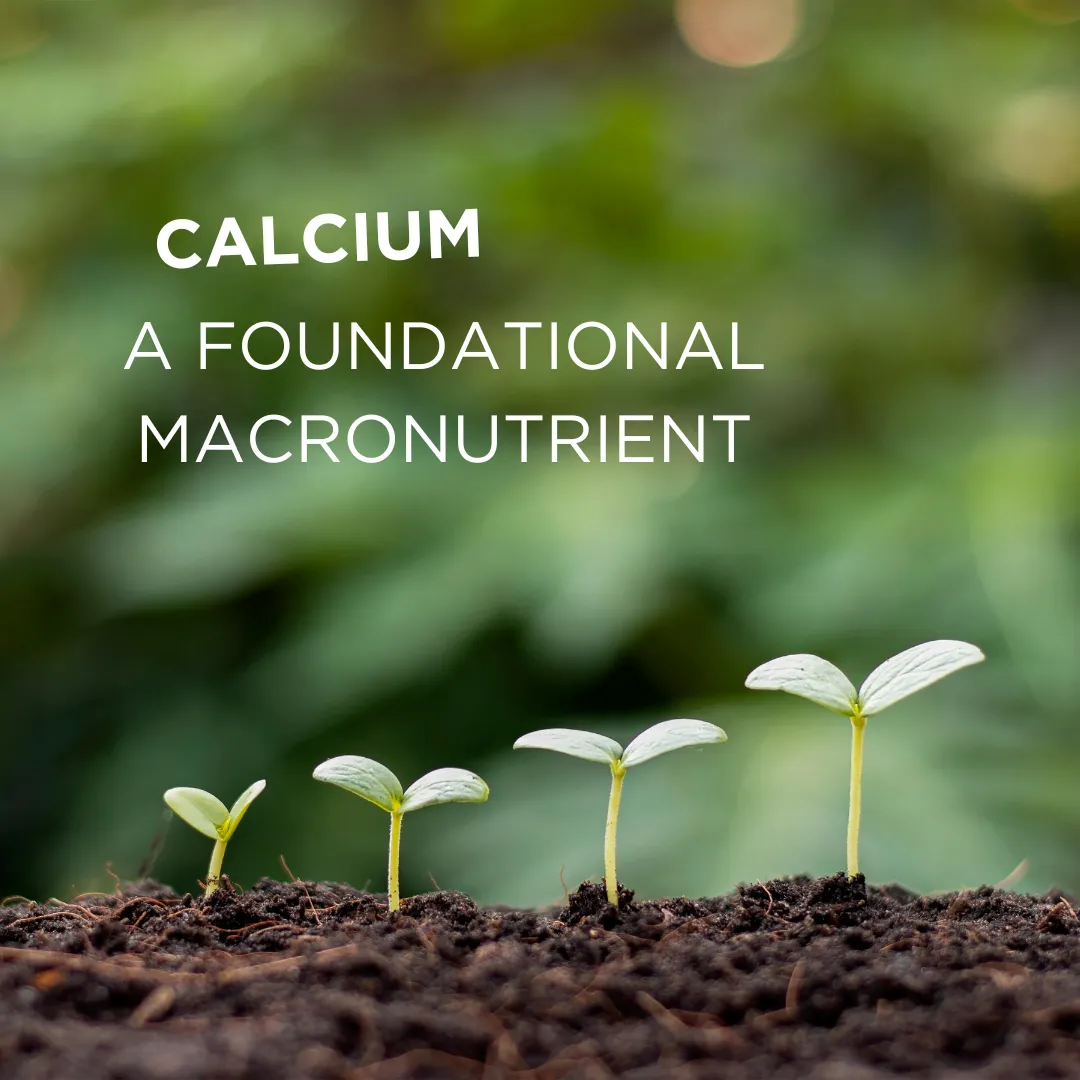Blog
Read our latest blogs

Calcium: A Foundational Macronutrient
Calcium: A Foundational Macronutrient
Calcium, it doesn’t just build strong bones. With the recent discussions of the importance of soil health and regeneration continuing to gain traction, there is a need to understand not only soil biology, but also the relationship of soil chemistry. These concepts should be revisited to challenge the standard operating procedures that have been ingrained in modern farming and agronomy. These same universally accepted procedures and nutritional recommendations have unfortunately set much of the industry in a diminishing return of short-term successes; however, the long-term effects have created a cascade of degrading consequences. Calcium is the cornerstone to positive cascading effects for nutritional balance and function in our soils and plants; without it in abundance, our systems will always be at a disadvantage to the challenges presented by nature.
Brief Overview on Calcium
Calcium (Ca2+) is present in soils as a divalent alkaline cation, often attaching to clay particles and present organic matter usually in the form of Ca sulfate and Ca carbonate. It often will be found in a varied ratio form with Potassium (K) and Magnesium (Mg), whose ideal ratio has been debated amongst agronomists. When there is an overabundance of one element, that dominant element will likely bind up the others, which makes them less available for root/plant update and cycling. A common understanding of Ca that is available in the soil profile for plant uptake will often be affected by the material of origin, in addition to the degree of weathering on that soil and potentially the pH[1]. Available Ca sets the foundation for optimal nutritional regulation and function within the soil root zone, the microbial community profile, and the plant.
Role of Calcium in Plant Physiology and Soil
In soil profiles with a higher top horizon clay content possessing a greater cation exchange capacity (CEC), there will likely be greater concentrations of sodium (Na) and/or magnesium (Mg) ions; elements that, when out of balance with Ca, can bind and reduce the available Ca to assist with flocculating the soil. When Ca is applied correctly to balance this ion ratio, it can lead to assistance with promoting soil particle flocculation, and a more ideal soil aggregation profile. This is what would be considered as “good tilth”, which is characterized by providing better aeration, rapid absorption of water, and an increase in water holding capacity availability; further creating an ideal environment for encouragement of plant root development and increased activity of microbial populations in the soil profile, which can then lead to greater nutrient and carbon cycling between the rhizosphere of the plant and the soil[2].
Along with creating a greater aggregate soil profile with more aeration and less compaction, abundant Ca in the soil can aid in mitigating the proliferation of undesirable weed species growth[3]. Weeds are often considered to be indicators of what a soil is lacking for desirable plants/crops to thrive- carbon/oxygen (likely due to anaerobic, compacted conditions), imbalanced nutrients, etc. As that imbalance is identified and corrected with proper amendment application and cultural practices, the growth and vitality of the weeds will eventually die off2. For example, many common grasses will establish themselves in soil profiles deficient in Calcium. Through proper testing and analysis of the soils, and correct rate of application of a bioavailable Ca source, the grasses will fade and return to the soil as mineral balance is restored. Eventually, those initial problematic weeds will be recycled back into the soil profile and become a carbon source to the microbial population in the form of organic matter.
Calcium plays a paramount role in the stimulation of root hair development along with the entire rooting system of the plant. Additionally, abundant calcium available for plant uptake will promote the growth of the plant tissues, especially the leaves for adequate photosynthetic activity. Calcium is a major contributor to healthy cellular membrane establishment, division, and function2. Calcium is one of four major macronutrients that drive vegetative tissue growth, the other three being Potassium (K), Nitrate (NO3-), and Chloride (Cl-). The major difference of Ca2+ compared to the others is that it will not have a negative effect on the reproductive tissue development that can often occur when the other three are applied and present for uptake in excess[4].
Calcium and its Role in Disease Management
Calcium also plays a vital role in disease resistance of soil and plant pathogens. Available Calcium for soil profiles, microbial populations, and plant uptake/development has been shown to have a plethora of beneficial attributes. Conversely, deficiencies of Calcium have been shown to produce plants with significantly heightened disease susceptibility regardless of the ratio of other nutrient elements in availability; soil temperature, air temperature, stage and time of plant development, or host variety are all less significant variables. Along with its properties of building strong and resilient roots and tissues, Calcium also possesses the ability to be an environmental detoxifier. Ca that is presently available via transmutation or chemical/physical bonding mitigates the concern of those toxic substances being taken up by plants or stifles the natural cycles (carbon, water, nutrient, etc.) by the soil microbial populations2.
Conclusion
Calcium is vital for soil and plant life to develop and function correctly at a foundational standpoint for all other nutrients to be in balance for utilization. It is necessary for many major properties in farming from stimulating soil microorganism growth and activity, development of strong cell wall membranes in root and plant tissues, improvement of soil structure through flocculating soil particles, and aiding in strengthening plant defense mechanisms all while not having a damaging effect on reproductive tissue growth. Calcium needs to be reconsidered as more of an essential macronutrient for fertility programs and not just a soil amendment3.
“You can’t have a healthy civilization without healthy soil. You can’t have junk food and have healthy people” -Joel Salatin
[1] Datnoff, L E, et al. Mineral Nutrition and Plant Disease. 2007. Second ed., St. Paul, Minnesota, American Phytopathological Society, 2023, pp. 141–143, 156–157.
[2] Andersen, Arden B. The Anatomy of Life & Energy in Agriculture. Acres U.S.A., 1989, pp. 11–15, 35–36, 52-53.
[3] Walters, Charles. Weeds Control Without Poisons. Acres U.S.A., 1999, pp. 11, 26, 123.
[4] Regenerative Agriculture Podcast. Advanced Eco Agriculture, 11 June 2024, regenerativeagriculturepodcast.com/episodes/short-1-macropak-and-the-importance-of-calcium/, Short #1. Accessed 12 June 2024. Podcast.
About Me
Lorem ipsum dolor sit amet, consectetur adipiscing elit. Phasellus malesuada nibh quam. A congue ante ultricies sit amet. Maecenas ante mauris, placerat in pretium non, sagittis a leo. Nulla feugiat ipsum facilisis finibus ornare. Donec placerat bibendum purus ac volutpat.
Maecenas ligula nisi, mollis ac nulla et, sagittis lobortis erat. Vestibulum rutrum at quam vitae consectetur. Suspendisse ullamcorper hendrerit turpis, ac cursus eros lacinia at. Donec vitae fermentum ligula. Sed porta ac ante ut maximus. Donec aliquet leo porta, viverra diam ut, accumsan metus.
Testimonials
“Mauris aliquam lobortis eros tincidunt sodales. Vestibulum non quam vitae sapien eleifend varius. Phasellus id metus mauris.”
“Mauris aliquam lobortis eros tincidunt sodales. Vestibulum non quam vitae sapien eleifend varius. Phasellus id metus mauris.”
“Mauris aliquam lobortis eros tincidunt sodales. Vestibulum non quam vitae sapien eleifend varius. Phasellus id metus mauris.”
Online Coaching Resources

Wellness eBook
Lorem ipsum dolor sit amet, consectetur adipiscing elit. Etiam varius purus nec lobortis vulputate.

The Essentials of Goal Setting
Lorem ipsum dolor sit amet, consectetur adipiscing elit. Etiam varius purus nec lobortis vulputate.

3 Week Career Workshop
Lorem ipsum dolor sit amet, consectetur adipiscing elit. Etiam varius purus nec lobortis vulputate.
Copyright ©2023 Regenerative Agriculture Solutions LLC. All rights reserved







